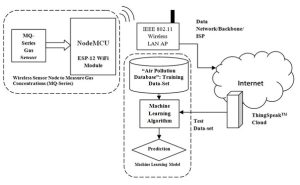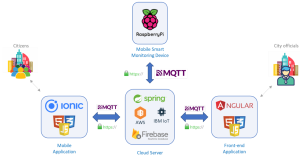REAL-TIME MAP-BASED POLLUTION MONITORING AND DATA MANAGEMENT SYSTEM
Introduction
This blog is based on air pollution which is one of the growing levels of concern all around the globe, and which is significantly impacting our health, environment as well as entire well-being. Earlier, people used to consider traditional monitoring methods which comes with limited reach as well as delayed data. This resulted in struggling with keeping a pace with the dynamic nature of pollution. However, this new wave of technology has emerged, which is called “Real-time Map Based Pollution” Monitoring. In this blog, it is going to show you the innovative system, which helps in exploring different components and benefits. These involves great level of potential that results in impacting for fighting for cleaner air.
.NET Project Reports
Understanding the system:
Based on the core of this system, which involves a network of different sensors which are strategically placed throughout the city or regions. All these sensors also very compact and low cist, which continuously helps in measuring different pollutants like particulate matter (PM2.5 and PM10), ozone (O3), nitrogen dioxide (NO2), and sulphur dioxide (SO2). All these collected data then get transmitted in a wireless manner to the central hub. The central hub also acts as a brain of the entire system. This also receives data streams from multiple sensors. This also processes the information and stores in a secured level of data base. The advanced algorithm can also get employed for analysing the data, for the identification of pollution hotspots. This also predicts future trends which are based on the pattern of weather, and other environmental factors.

The final and the most user-friendly component reflects the map-based interface. This interface, is completely accessible through web browsers and mobile applications. Later on, it get translated to the complex data into a readily understandable format. With the help of this real-time pollution the users can easily see the different levels which are displayed on a map, which also include coding. This helps in allowing the individuals in order to make informed level of decision regarding the daily routines. This planning includes different outdoor activities for choosing exercise routes for lower level of pollution.
Benefits of real-time system:
There are various level of benefits for the utilization of real time map-based pollution monitoring system:
- Enhanced public awareness: The overall system helps in empowering the citizens with the real-time information regarding quality of air of the immediate surroundings. This helps in providing knowledge which allows them for taking various preventive measures in order to protect their health. This can be seen especially for the vulnerable populations like children or elderly people.
- Improved decision-making: This real-time data helps in empowering policymakers with valuable level of insights into pollution patterns and sources. This helps in allowing them for developing the targeted regulations. This can be done with the help of implementing effective pollution control strategies and track the level of effectiveness of the existing measures.
- Empowering research and innovation: There is a vast amount of data which has been collected by the system which helps in goldmining for the researchers. With the help of analysing the historical and real-time data, scientists can also gain a deep level of understanding in regards to the pollution dynamics. This also helps in leading to advancement in air quality prediction and mitigation techniques.
- Promoting transparency and accountability: The nature of this real-time nature of the system helps in fostering the level of transparency with the help of providing readily accessible data open for all.

The Road Ahead:
This “Real-Time Map-Based Pollution Monitoring and Data Management System’s is highly evolving which holds an immense level of potential for revolutionizing our approach to the management of air quality. With the help of integrating the sensor networks, data analytics, and user-friendly interfaces, these system helps in empowering all the stakeholders for playing a crucial role towards creating a clean and pure air for a healthier future.
Assignment Writing Services
Technical Aspect
The level of effectiveness of “Real-Time Map-Based Pollution Monitoring and Data Management System” also get affected by the technological foundations. This involves different components including some of the key areas such as:
- Sensor Network: The overall system highly relies on the network with diverse sensors in which each plays a crucial role. Including optical sensors which helps in measuring light scattering by particulate matter which helps in providing data on PM 2.5 and PM10 levels. Thereafter, some of the electrochemical sensors which helps in detecting specific gases like NO2 and SO2 with the help of measuring their electrical properties while interacting with the sensors. There are “Metal Oxide Semiconductors (MOS) sensors which helps in offering broad detection of various pollutants.
- Data transmission: There are various sensors which helps in transferring data wirelessly with the help of using different protocols such as Wi-Fi, Bluetooth Low Energy (BLE) or other cellular networks. With the help of selecting an ideal protocol it highly depends on different factors that ranges power consumption and network availability.
- Central Hub and Data management: The central hub helps in receiving the data streams from different sensors which helps in performing the real-time data processing, which also stores the overall data in secure manner. This cloud computing platforms helps in offering a scalable and cost-effective solution for data storage and management.
This Real-Time Map-Based Pollution Monitoring System get extended beyond the public awareness which helps in offering different applications such as precision health management for different individuals with respiratory conditions. This helps in contributing towards smart city initiatives with the help of monitoring and enforcements.
Online Assignment Writing Services
Conclusion
In conclusion, it can be said that, the “Real-Time Map-Based Pollution Monitoring and Data Management System”, helps in offering a powerful tool for making air cleaner. With the help of providing real-time information, it empowers the stakeholders for driving innovation. These systems helps in paving the way for future with clear air which is not privilege, but not the basic right. This success of such system also interrupts the collective effort. This continuous technological advancement has a strong level of data security measures and responsible citizen engagement which is highly crucial in different aspects for achieving a sustainable future with clean air to breathe.
